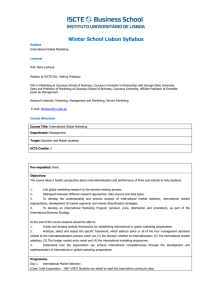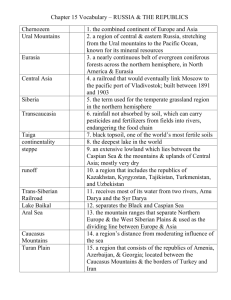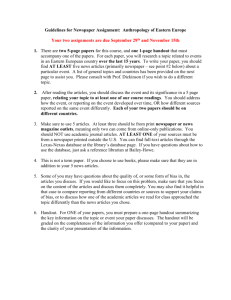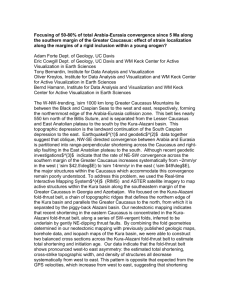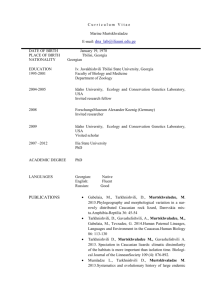O F C O N F L I... in Central Asia and the South Caucasus
advertisement
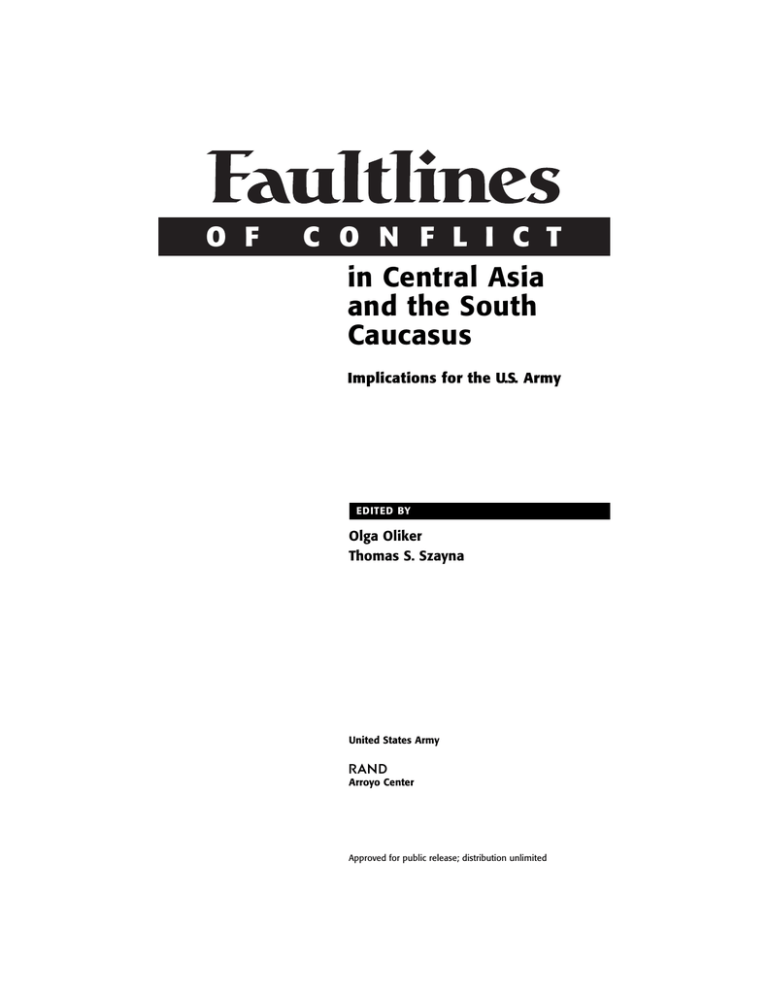
O F C O N F L I C T in Central Asia and the South Caucasus Implications for the U.S. Army EDITED BY Olga Oliker Thomas S. Szayna United States Army R Arroyo Center Approved for public release; distribution unlimited The research described in this report was sponsored by the United States Army under Contract No. DASW01-01-C-0003. Library of Congress Cataloging-in-Publication Data Oliker, Olga. Faultlines of conflict in Central Asia and the south Caucasus : implications for the U.S. Army / Olga Oliker, Thomas Szayna.. p. cm. Includes bibliographical references. “MR-1598.” ISBN 0-8330-3260-7 1. Asia, Central—Strategic aspects. 2. Caucasus—Strategic aspects. 3. United States—Military policy. 4. United States. Army—Foreign service—Asia, Central. 5. United States. Army—Foreign service—Caucasus. I. Szayna, Thomas S. II. Rand Corporation. III.Title. UA832.2 .O42 2003 355'.033058—dc21 2002012824 RAND is a nonprofit institution that helps improve policy and decisionmaking through research and analysis. RAND ® is a registered trademark. RAND’s publications do not necessarily reflect the opinions or policies of its research sponsors. © Copyright 2003 RAND All rights reserved. No part of this book may be reproduced in any form by any electronic or mechanical means (including photocopying, recording, or information storage and retrieval) without permission in writing from RAND. Published 2003 by RAND 1700 Main Street, P.O. Box 2138, Santa Monica, CA 90407-2138 1200 South Hayes Street, Arlington, VA 22202-5050 201 North Craig Street, Suite 202, Pittsburgh, PA 15213-1516 RAND URL: http://www.rand.org/ To order RAND documents or to obtain additional information, contact Distribution Services: Telephone: (310) 451-7002; Fax: (310) 451-6915; Email: order@rand.org O F C O N F L I C T in Central Asia and the South Caucasus Implications for the U.S. Army The South Caucasus Central Asia PREFACE This report is the final product of a project entitled “Sources of Conflict in the South Caucasus and Central Asia.” The project was intended to help Army intelligence analysts improve their understanding of the potential for armed conflict in the region of Central Asia and South Caucasus and how such outbreaks might escalate to a level that could involve U.S. forces. This report identifies and evaluates the key conflict-producing faultlines in Central Asia and South Caucasus. The faultlines include the role of state political and economic weakness; the impact of crime and the drug trade; the effects of ethnic tensions and foreign interests and influence; and the impact of competition for natural resources. The analysis then examines the ways in which the emergence of conflict could draw the United States into the strife. The report also examines the operational challenges the region poses for possible Army deployments in the 10- to 15-year time frame. This research was completed largely prior to the September 11 attacks on the United States. The report has been updated to take into account the changed security environment and the U.S. military presence on the ground in the Central Asian and South Caucasus region. The operations in Afghanistan have not altered the faultlines. They are long-term and structural in nature. The current U.S. presence on the ground means that they need to be taken into account even more than previously. The research was sponsored by the Office of the Deputy Chief of Staff for Intelligence, U.S. Army, and conducted in the Strategy, Doctrine, and Resources Program of RAND Arroyo Center. The Arroyo Center vii viii Faultlines of Conflict in Central Asia and the South Caucasus is a federally funded research and development center sponsored by the United States Army. Comments or requests for further information are welcome; please contact the report editors, Olga Oliker (oliker@rand.org) and Thomas Szayna (szayna@rand.org). For more information on RAND Arroyo Center, contact the Director of Operations (telephone 310-393-0411, extension 6500; FAX 310451-6952; e-mail donnab@rand.org), or visit the Arroyo Center’s Web site at http://www.rand.org/ard/. CONTENTS Preface ......................................... vii Figures ......................................... xv Tables.......................................... xvii Summary ....................................... xix Acknowledgments................................. xxvii Chapter One INTRODUCTION Thomas S. Szayna and Olga Oliker .................. 1 The Context .................................. Objectives, Approach, and Organization ............. 1 3 Chapter Two THE POLITICAL EVOLUTION OF CENTRAL ASIA AND SOUTH CAUCASUS: IMPLICATIONS FOR REGIONAL SECURITY Tanya Charlick-Paley with Phil Williams and Olga Oliker . 7 Introduction .................................. Political Institutionalization, Deprivation, and State and Societal Capacity: A Framework for Risk Analysis ... Institutionalization in Central Asia and South Caucasus: Rating the Risk of Internal Conflict .............. The Role of Islam............................... Political Landscape: Conclusions .................. Proximate Causes of Conflict in Central Asia and South Caucasus................................. ix 7 9 15 21 28 29 x Faultlines of Conflict in Central Asia and the South Caucasus The Ferghana Valley and Cross-Border Incursions ...... Nagorno-Karabakh ............................. Georgian Separatists and Russia ................... Conclusions .................................. 31 34 36 39 Chapter Three SOME ECONOMIC DIMENSIONS OF SECURITY IN CENTRAL ASIA AND SOUTH CAUCASUS Abraham S. Becker.............................. 41 Introduction .................................. Regional Overview.............................. Poverty .................................... Dependence ................................ Prospects .................................... 41 47 47 53 63 Chapter Four CRIMINALIZATION AND STABILITY IN CENTRAL ASIA AND SOUTH CAUCASUS Phil Williams ................................. 71 Introduction .................................. Characteristics of Central Asia and South Caucasus ..... The Criminalization Syndrome .................... Organized Crime ............................. Drug Trafficking.............................. The Shadow Economy ......................... Corruption and Rent Seeking .................... Costs and Benefits of Criminalization .............. Governance and Criminalization in Central Asia and South Caucasus ............................ Sultanistic Regimes ........................... Contested States ............................. Governance, Criminalization, and Instability in Central Asia and South Caucasus ..................... The Collapse of Sultanistic Regimes ............... The Escalation or Resurgence of Violence in Contested States ................................... Conclusions .................................. 71 73 77 78 83 88 90 93 94 95 97 99 99 105 107 Contents Chapter Five NATURAL RESOURCES AND POTENTIAL CONFLICT IN THE CASPIAN SEA REGION Sergej Mahnovski .............................. xi 109 Introduction .................................. Fossil Fuel Production in the Caspian Sea Region ....... Crude Oil................................... Natural Gas................................... Fossil Fuel Transport to Markets ................... Crude Oil .................................... Current Transport Options...................... Medium Term (until 2005) ...................... Longer Term (2005–2010)....................... Natural Gas................................... Western Markets ............................. Eastern Markets.............................. Other Options for Natural Gas? .................. Energy Relationships in the Caspian Sea Region ........ Interstate Dynamics .......................... Intrastate Dynamics .......................... The Role of Water and Electricity in Central Asia ....... Can Natural Resources Contribute to Armed Conflict? ... Resources as Target of Conflict: Infrastructure Sabotage ................................. Resources as Cause of Conflict: Competition over Distribution of Wealth ....................... Some Potential Mitigating Factors to Conflict.......... Caspian Sea Territorial Disputes ................. Petroleum Funds ............................. Water Management Strategies ................... Conclusions .................................. 109 110 110 112 115 115 115 116 119 120 122 123 125 127 127 130 131 134 136 138 138 140 141 143 Chapter Six POTENTIAL FOR ETHNIC CONFLICT IN THE CASPIAN REGION Thomas S. Szayna .............................. 145 Introduction .................................. The Ethnic Factor in the CASC States ................ Preconditions for Ethnic Conflict ................... 145 147 161 134 xii Faultlines of Conflict in Central Asia and the South Caucasus Kazakhstan: An Example of a Nationalizing State ....... Catalysts to Ethnic Violence ...................... Potential for Ethnic Violence in the CASC Region ....... Central Asia ................................. South Caucasus .............................. Final Observations ............................. 166 173 176 176 179 181 Chapter Seven CONFLICT IN CENTRAL ASIA AND SOUTH CAUCASUS: IMPLICATIONS OF FOREIGN INTERESTS AND INVOLVEMENT Olga Oliker ................................... 185 Introduction .................................. Russia....................................... Turkey ...................................... The European Union and Its Member States .......... Iran ........................................ China ....................................... Afghanistan................................... The United States .............................. India and Pakistan.............................. Great Power Competition and Great Power Conflict ..... The Local Perspective ........................... Conclusions .................................. 185 189 199 206 208 213 217 220 225 226 228 239 Chapter Eight CENTRAL ASIA AND SOUTH CAUCASUS AS AN AREA OF OPERATIONS: CHALLENGES AND CONSTRAINTS William D. O’Malley ............................ 241 Introduction .................................. Deployment .................................. Deployment by Air ............................. By Sea....................................... Infrastructure: Transiting the Central Asia and South Caucasus Region ........................... Rail ........................................ Road........................................ Water ....................................... 241 243 249 258 260 261 262 262 Contents xiii Air: Possible Staging Locations for U.S. Forces Operating Within or Outside The Region ................. Intermediate Support Base Possibilities .............. Operational Environment ........................ South Caucasus................................ Armenia ................................... Azerbaijan .................................. Georgia .................................... Central Asia .................................. Kazakhstan ................................. Kyrgyzstan.................................. Tajikistan .................................. Turkmenistan ............................... Uzbekistan ................................. Operational Environment: Implications ............. Local Military Capabilities: Capacity and Interoperability Directions of Military Reform in Central Asia and South Caucasus ............................ Implications for U.S. Forces: Interoperability and Requirements ............................. Conclusions .................................. 263 269 272 276 276 277 279 281 281 283 286 287 288 290 292 296 299 Chapter Nine SOURCES OF CONFLICT AND PATHS TO U.S. INVOLVEMENT Olga Oliker and Thomas S. Szayna .................. 307 Central Asia .................................. Kazakhstan ................................. Kyrgyzstan.................................. Tajikistan .................................. Turkmenistan ............................... Uzbekistan ................................. Trans-Central Asian Conflict .................... South Caucasus................................ Armenia ................................... Azerbaijan .................................. Georgia .................................... Trans-Caucasus Conflict ....................... Trans-Caspian Conflict ........................ 311 311 315 320 325 330 336 338 338 340 345 349 350 xiv Faultlines of Conflict in Central Asia and the South Caucasus Paths to Conflict and U.S. Involvement .............. Conflict Likelihood, Conflict Severity, and Potential for Army Deployment .......................... 352 Bibliography ..................................... 359 352 FIGURES The South Caucasus and Central Asia ........... frontispiece 2.1. The Ferghana Valley ......................... 5.1. Caspian Contribution to World Crude Oil Production ................................ 5.2. Caspian Contribution to Non-OPEC Crude Oil Production ................................ 5.3. Caspian Crude Oil Production Forecasts .......... 5.4. Caspian Crude Oil Export Potential Forecasts....... 5.5. Caspian Natural Gas Production Forecasts......... 5.6. Caspian Natural Gas Export Potential Forecasts ..... 5.7. Oil and Natural Gas Existing and Proposed Pipelines . 5.8. Per-Capita Electricity Generating Capacity by Plant Type ................................ 6.1. Ethnic Heterogeneity in the CASC States .......... 6.2. Extent of Democratization in the CASC States ...... 6.3. Extent of Demographic Shift in Kazakhstan, 1989–1999................................. 7.1. Foreign Interests in Central Asia and South Caucasus ................................. 8.1. Airfields in South Caucasus .................... 8.2. Airfields in Central Asia ....................... 8.3. Air Distances Between Staging and Deployment Locations ................................. 8.4. Airfields in Turkey ........................... 8.5. Airfields in Southern Russia .................... 8.6. Airfields in Iran ............................. 8.7. South Caucasus ............................ xv 32 111 111 112 113 114 114 116 132 158 162 169 227 253 254 255 270 271 273 277 xvi Faultlines of Conflict in Central Asia and the South Caucasus 8.8. Central Asia ............................... 9.1. Notional Representation of Conflict Severity, Conflict Likelihood, and the Potential for Army Deployment in Central Asia and South Caucasus .... 282 353 TABLES 3.1. Central Asia and South Caucasus: Demographic Indicators, 1999 ............................ 3.2. Central Asia and South Caucasus: Economic Welfare Indicators, 1999 ............................ 3.3. Central Asia and South Caucasus: Trade Dependence Ratios, 1990 and 1999 ........................ 3.4. Foreign Trade Concentration in Central Asia and South Caucasus, 2000 ........................ 3.5. Central Asia and South Caucasus: Public Sector Debt and Debt Service, 1999 ................... 3.6. Public-Sector External Debt of Four CASC States, End 1999.................................. 4.1. Shadow Economy Size Relative to Official GDP ..... 5.1. Options for Monetizing Stranded Natural Gas ...... 5.2. Stakeholders in Caspian Energy Developments ..... 5.3. Water Relationships in Central Asia .............. 6.1. Overall Population Estimates, CIA and UN, CASC Region............................... 6.2. Main Ethnic Groups, Armenia .................. 6.3. Main Ethnic Groups, Azerbaijan ................ 6.4. Main Ethnic Groups, Georgia .................. 6.5. Main Ethnic Groups, Kazakhstan ................ 6.6. Main Ethnic Groups, Kyrgyzstan ................ 6.7. Main Ethnic Groups, Tajikistan ................. 6.8. Main Ethnic Groups, Turkmenistan .............. 6.9. Main Ethnic Groups, Uzbekistan ................ 8.1. Key Brigade Combat Team Characteristics and Lift Requirements .............................. xvii 48 49 54 55 60 61 90 121 128 133 147 149 150 152 153 154 155 156 157 244 xviii Faultlines of Conflict in Central Asia and the South Caucasus 8.2. 8.3. 8.4. 8.5. 8.6. 8.7. 9.1. 9.2. 9.3. 9.4. 9.5. 9.6. 9.7. 9.8. Infrastructure Requirements by Aircraft Type....... Estimated Days to Close by Air ................. Strategic Sealift Ship Characteristics ............. Relative Measures of Domestic Stability ........... Transportation Infrastructure and Support Capabilities Vary Dramatically Across South Caucasus and Central Asia ................ Snapshot of the Relative Capabilities of the Militaries of Each Country ..................... Indicators of Conflict: Kazakhstan............... Indicators of Conflict: Kyrgyzstan ............... Indicators of Conflict: Tajikistan ................ Indicators of Conflict: Turkmenistan............. Indicators of Conflict: Uzbekistan ............... Indicators of Conflict: Armenia ................. Indicators of Conflict: Azerbaijan ............... Indicators of Conflict: Georgia ................. 250 257 259 302 303 304 314 319 325 329 336 340 344 349 SUMMARY Violent conflict is likely to be a continuing problem in Central Asia and South Caucasus over the next 10 to 15 years. Violent clashes within and between states in this region have already occurred, and they are likely to occur again. Depending on how the region develops, the form and degree of conflict may or may not grow to involve other states, including the United States and its interests. This analysis considers some of the most important factors underlying the likelihood of conflict in the region, assessing their implications for regional stability and for U.S. interests and potential involvement over the next 10 to 15 years. It also provides some preliminary thoughts on the implications of the ongoing U.S. presence in and near the region. None of the sources of conflict described in this report operate in a vacuum. Economic, political, ethnic, and religious factors all combine with the impact of foreign interests to make conflict more or less likely. This analysis suggests, however, that the key factor for the likelihood of regional conflict is the regimes themselves; their weaknesses and volatilities leave them increasingly unable to withstand challenges posed by other faultlines. When regimes collapse, these politically and economically weakened countries may experience armed strife. The specifics of how this happens can vary. Unintegrated and/or alienated minorities who link their economic deprivation and political oppression to ethnicity or religion can be expected to organize. But if there are no political institutions to channel their participation, their efforts to do so will put them in conflict with the state and pos- xix xx Faultlines of Conflict in Central Asia and the South Caucasus sibly with each other. The absence of effective political institutions makes it more likely that public discontent will take extralegal forms. Moreover, civil strife and potential state failure resulting from a succession crisis is possible in the next 15 years in almost all of these states, except perhaps Armenia. It is most likely in the near term in Azerbaijan and Georgia. Azerbaijan’s president is aging and ailing. He has indicated that he hopes his son will succeed him. Georgia’s president Eduard Shevardnadze, also over 70 years of age, has said that he will not run again when his term expires in 2005. Ethnic heterogeneity, a necessary but not sufficient condition for ethnic conflict, is present in almost all the states of the region (Armenia and, to a lesser extent, Azerbaijan are the exceptions). In this part of the world, however, ethnic diversity exists side by side with wide economic disparities and state policies of “ethnic redress” that privilege the titular nationality over others—including those who once enjoyed more advantages. Weak institutions and limited central control make it more likely that dissatisfied groups will have the capacity to mobilize and acquire weaponry. If this happens, the state itself is likely to respond with violence. At the interstate level, these internal dynamics may well make conflict with other states more likely, as leaders seek to unite a people of an increasingly contested state behind them, or seek to strike first before another state can undermine their power, or simply behave in an aggressive manner. Pretexts for interstate conflict in this region abound, as borders drawn up in Soviet times fail to follow ethnic lines (or, in most cases, economic “common sense” lines), giving many states a claim on the territory of others. It is expected that territorial disputes may well lead to some forcible readjustment of borders. Such disputes may also serve as a proximate cause of crossborder adventurism by some states. In addition to insurgency attacks, territorial claims and efforts to “defend” co-ethnics by one or another state could escalate conflict to an interstate level. In Central Asia, border conflicts are most likely in the Ferghana Valley. In the South Caucasus, the risk remains that Nagorno-Karabakh will flare up once again. The states’ economic condition reflects the political situation. Both poverty and economic dependence are prevalent in all eight states under consideration. The people of Central Asia and South Caucasus Summary xxi are by and large in worse shape economically than they were under Soviet rule, with at least half living at or below the poverty line according to their own national statistics. What wealth there is, is highly concentrated in the hands of a very small minority, and social services are minimal. Moreover, while trade has begun to shift somewhat toward partners in Europe, the states of Central Asia and South Caucasus remain significantly dependent on Russia. Russian efforts to increase regional economic integration could, if successful, keep these states from many of the potential benefits of involvement in the globalized economy. Finally, while the energy producers may place most of their hope in expected revenues from energy exports (although they then run the risk of both resources and foreign investment becoming diverted entirely to the energy sector, with little gain for the rest of the economy), all the states of the region will require fundamental—and probably painful—reforms before their economies can truly begin to develop. In an economically backward and depressed situation such as this, it is not uncommon to see the rise of criminal activity and corruption. The drug trade and other criminal activities give people a means of economic activity, alleviating poverty and providing employment. Corruption and bribery make it possible to get things done. Thus, crime in such a situation has both positive and negative effects. Estimates suggest that in much of the Central Asian and South Caucasus region, the shadow, or illegal, economy is approaching the size of the legal economy. If it could be quantified and included, it would double the GDP. This means both that studies of the legal economy alone understate the economic deprivation, and that the prospects for growth are probably lower than the studies indicate, because the long-term effects of a criminalized economy are overwhelmingly negative. Bad business drives out good, preventing investment and growth. Corruption weakens the state’s ability to govern, decreasing trust in it and making it tremendously inefficient, as nothing gets done without bribes. Moreover, in Central Asia and South Caucasus, the significant component of the criminal economy that is linked to the drug trade has its own repercussions. The region has already become an important route for drugs flowing from Afghanistan. Increasingly, production is moving into states like Tajikistan, as well. Drug use is on the rise, straining already limited public health resources and increasing the danger of AIDS, and proceeds from drug xxii Faultlines of Conflict in Central Asia and the South Caucasus trafficking are reportedly sometimes used (although the extent is unknown) to fuel the insurgencies that threaten local governments. Resource development, too, has its positive and negative aspects. The Caspian oil-producing states, Azerbaijan and Kazakhstan, have the greatest prospects for finding hard currency markets abroad. Turkmenistan and Uzbekistan, which produce gas but have very little export potential for their limited oil production, are unlikely to find a market outside the regional one, as monetization of natural gas resources is a far more difficult endeavor. As for the rest of the states of the region, Georgia has hopes of becoming a transit state for Caspian oil and reaping some economic benefits in this way, but Armenia, Tajikistan, and Kyrgyzstan have few prospects in this regard. Moreover, recent droughts have exacerbated the fact that the have/have-not situation with energy is largely reversed when it comes to water. The fossil fuel–poor upstream countries, Kyrgyzstan and Tajikistan, lie at the headwaters of the Syr Darya and Amu Darya rivers, which provide the means for hydroelectric power generation. The fossil fuel–rich downstream countries, Kazakhstan, Uzbekistan, and Turkmenistan, rely on this water for the irrigation of extensive cotton and grain fields. Arguments over when to release this water have led to repeated energy shut-offs and international disputes, while among the Caspian littoral states, disagreement over the division of the seabed has led to the increasing militarization of that body of water, as each state seeks to protect its claims. Resource competition and crime and the drug trade are overall less likely to serve as proximate causes of conflict than as aggravating factors, making conflict more likely, more intense, and more likely to spread. However, disputes over territory in the resource-rich Caspian Sea itself can also heighten tension. Foreign involvement to contain a developing crisis may also exacerbate the situation, for example, prolonging conflict and involving more states, while criminal support of insurgency groups, perhaps with drug money, can keep the conflict going longer than it otherwise might. Foreign interests, whether or not they themselves spur conflict, will have an impact on how it develops, and outside actors are likely to get involved if it does. Russia, China, Turkey, Iran, and the United States may seek to defend their interests in the region, whether those derive from shared ethnic characteristics, hopes for pipelines to carry Summary xxiii Caspian energy resources to and through their states, fears of conflict spreading beyond the region, or a desire to demonstrate strength and influence. Foreign state and nonstate actors have also supported insurrectionist and secessionist movements within Central Asia and South Caucasus, seeking to advance strategic and/or ideological (and religious) goals. And as the U.S. response to terrorist attacks on its soil in September 2001 evolves, the region acquires a new set of concerns, including the implications of continued war in Afghanistan, the possibility of unrest in Pakistan, and the short- and long-term impact of U.S. force presence in the region. The situation in Afghanistan and Pakistan, as well as the troop presence of U.S., Russian, and other forces in the region may serve to catalyze state failure in a number of ways, perhaps making significant conflict more proximate than it might otherwise have been. Refugee flows into the region could strain the treasuries and stretch the capacities of states to deal with the influx. They can also potentially be a mechanism for countergovernment forces to acquire new recruits and assistance. This is of particular concern given the history of Al Qaeda and Taliban support to insurgent groups in Central Asia, as well as the ethnic links and overlaps between Afghanistan and the Central Asian states. To date, the rise of insurgencies linked to radical Islam has either caused or provided an excuse for the leadership in several states to become increasingly authoritarian, in many ways aggravating rather than alleviating the risk of social unrest, and it is entirely plausible that this trend will continue. Moreover, if the U.S.-Russian relationship improves, Russian officials may take advantage of the opportunity, combined with U.S. preoccupation with its counterterror campaign, to take actions in Georgia and Azerbaijan that these states will perceive as aggressive. Meanwhile, U.S. forces in the region may be viewed as targets by combatants in the Afghanistan war and by insurgent efforts against the Central Asian governments. The situation in Afghanistan will almost certainly have an impact on the faultlines in Central Asia and possibly those in the South Caucasus. While it remains too early to predict just what that impact might be, regardless of the situation in Afghanistan, there remains excellent reason to believe that over the next 15 years separatists will continue to strive to attain independence (as in Georgia) and insurgency forces to take power (as in Uzbekistan, Kyrgyzstan, and Tajikistan). xxiv Faultlines of Conflict in Central Asia and the South Caucasus This could spread from the countries where we see it currently to possibly affect Kazakhstan, Turkmenistan, and Azerbaijan. It could also result in responses by states that see a neighboring insurgency as a threat, and by others that pursue insurgents beyond their own borders. Insofar as U.S. forces stay involved in the region, it could draw the United States into these Central Asian and South Caucasus conflicts. Even before September 11, 2001, the United States was involved in Central Asia and South Caucasus. Diplomatic ties, economic assistance, economic interests, and military engagement through NATO’s Partnership for Peace and bilateral cooperation varied in intensity from state to state, but were significant with several. Caucasus states Georgia and Azerbaijan hoped that U.S. engagement, as well as close ties with neighbor Turkey, might translate into NATO support against Russian political, economic, and military pressure (or, at least, a perception by Russia that NATO support was possible). Central Asian states such as Uzbekistan and Kyrgyzstan received assistance that they hoped would help them with challenges posed by Al Qaeda- and Taliban-supported insurgency groups that sought to destabilize their governments. These states also saw U.S. assistance as a possible alternative to dependence on Russia, and, in the case of Uzbekistan, a means of further strengthening its own regional role. Thus, while in the near term it seems likely that the United States presence will be geared to the counterterror campaign in and around Afghanistan, U.S. interests in the region extend beyond the present campaign. Depending on how ties with the Central Asian states develop, and on the future path of the counterterrorist effort, future activities may involve more counterterrorist efforts into Afghanistan (and perhaps Pakistan), supporting the Central Asian states in their counterinsurgency efforts, peacemaking or peacekeeping after conflict emerges in the region, or responding to terrorist groups on the territories of Central Asian states themselves. Moreover, even if the United States is less involved, a crisis in Central Asia or in the South Caucasus could lead to the deployment of international peacekeepers or peacemakers, to include U.S. forces, protection of energy and pipeline infrastructure throughout the region, and protection and evacuation of U.S. and other foreign nationals. The same factors that make conflict more likely—ethnic cleavages, economic hardship, high crime rates, rampant corruption, etc.—also Summary xxv complicate any and all efforts, military, economic, or otherwise, in the region. Whatever the extent and form of the longer-term U.S. presence in the region, it will therefore be challenging—and challenged. Even without these problems, the terrain is difficult and distances are substantial, while infrastructure throughout the region leaves much to be desired. With U.S. troops already in place to varying extents in Central Asian and South Caucasus states, it becomes particularly important to understand the faultlines, geography, and other challenges this part of the world presents. U.S. forces will face them in one way or another regardless of the depth of their commitment to the region. The current situation, however, suggests that they may face them somewhat sooner than might once have been expected. ACKNOWLEDGMENTS The authors would like to thank LTG Robert W. Noonan, Jr., for sponsoring this research. We also thank Mr. William Speer, Mr. Eric Kraemer, LTC John D. Cecil, and MAJ Donald L. Gabel, currently or previously with the Office of the Deputy Chief of Staff for Intelligence, U.S. Army, under whose auspices this work was undertaken. We would like to acknowledge the useful insights provided in discussions following intermediate briefings of this project at DCSINT by DCSINT staff as well as by Mr. Lester Grau of FMSO, Mr. Alan R. Goldman, Mr. David Merchant, and LTC David O. Grimmet of NGIC, Dr. Joel Shapiro of DIA, and Mr. Shaughnessy of HQ TRADOC. At RAND, David Kassing provided many valuable suggestions and comments throughout the research and writing process, and Roy Gates assisted in gathering and interpreting information on regional airfields and other facilities. Valuable insights were gleaned from meetings and discussions with LTC Peter A. DeLuca (then at U.S. European Command); LTC Keith D. Solveson (then at the Center for Army Analysis); LTC Prine-Rincon, Mr. Creque, Mr. Fowler, LTC Glover, LTC Cozzie, LTC Hayman, LTC Bonnadonna, MAJ Kron, and LTC Hill at U.S. Central Command; Commander Thom W. Burke of the Joint Staff; and Ms. Lorna Jons, MAJ Walter Grissom, and LTC Richard C. Choppa at the Office of the Secretary of Defense. The suggestions and comments of Dr. Nora Bensahel and Dr. Adam Stulberg greatly enhanced the report’s quality, and we are grateful to them for their time and effort. Pamela Thompson and Joanna Alberdeston at RAND were crucial in the preparation of the report, and Nikki Shacklett served as editor. xxvii
